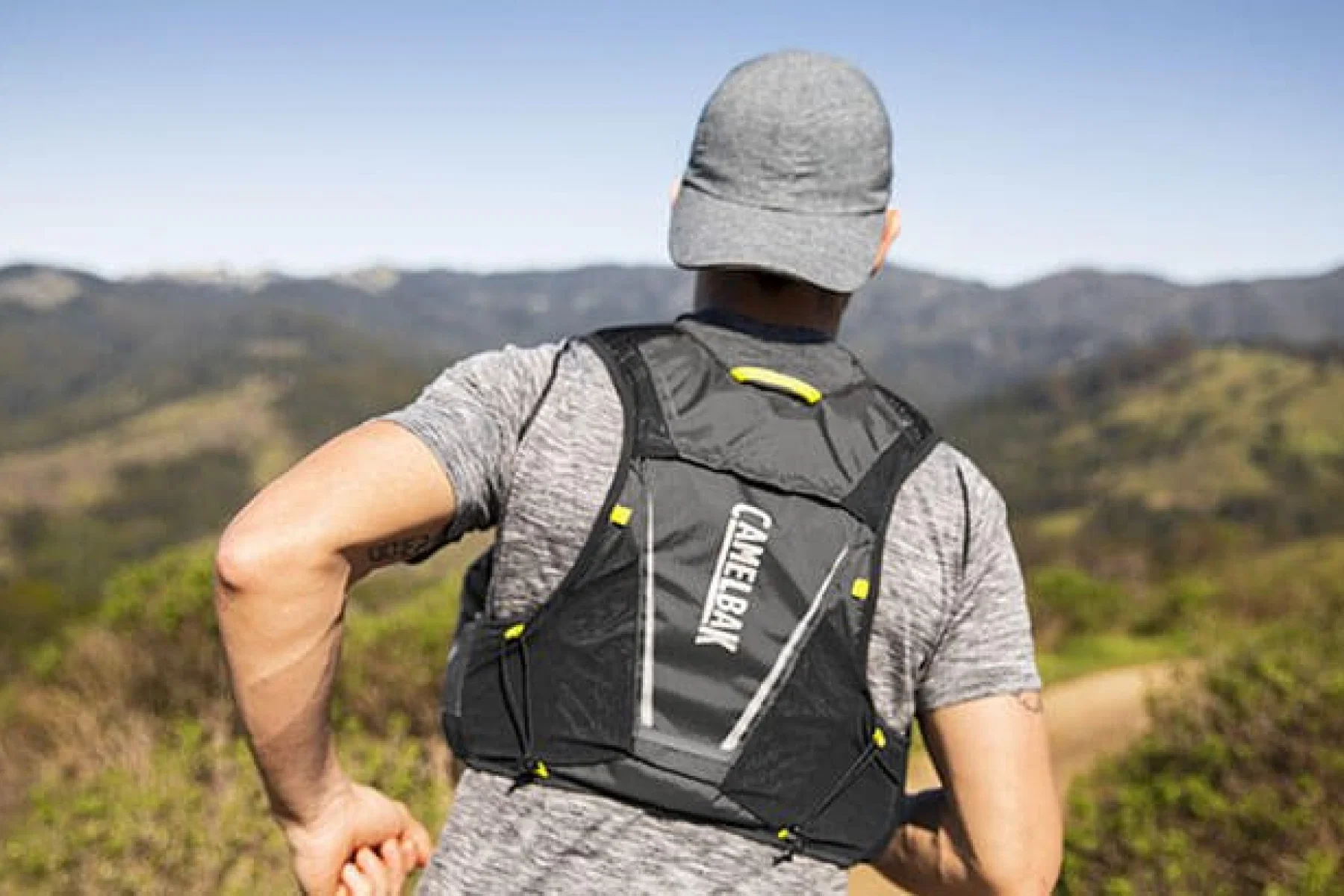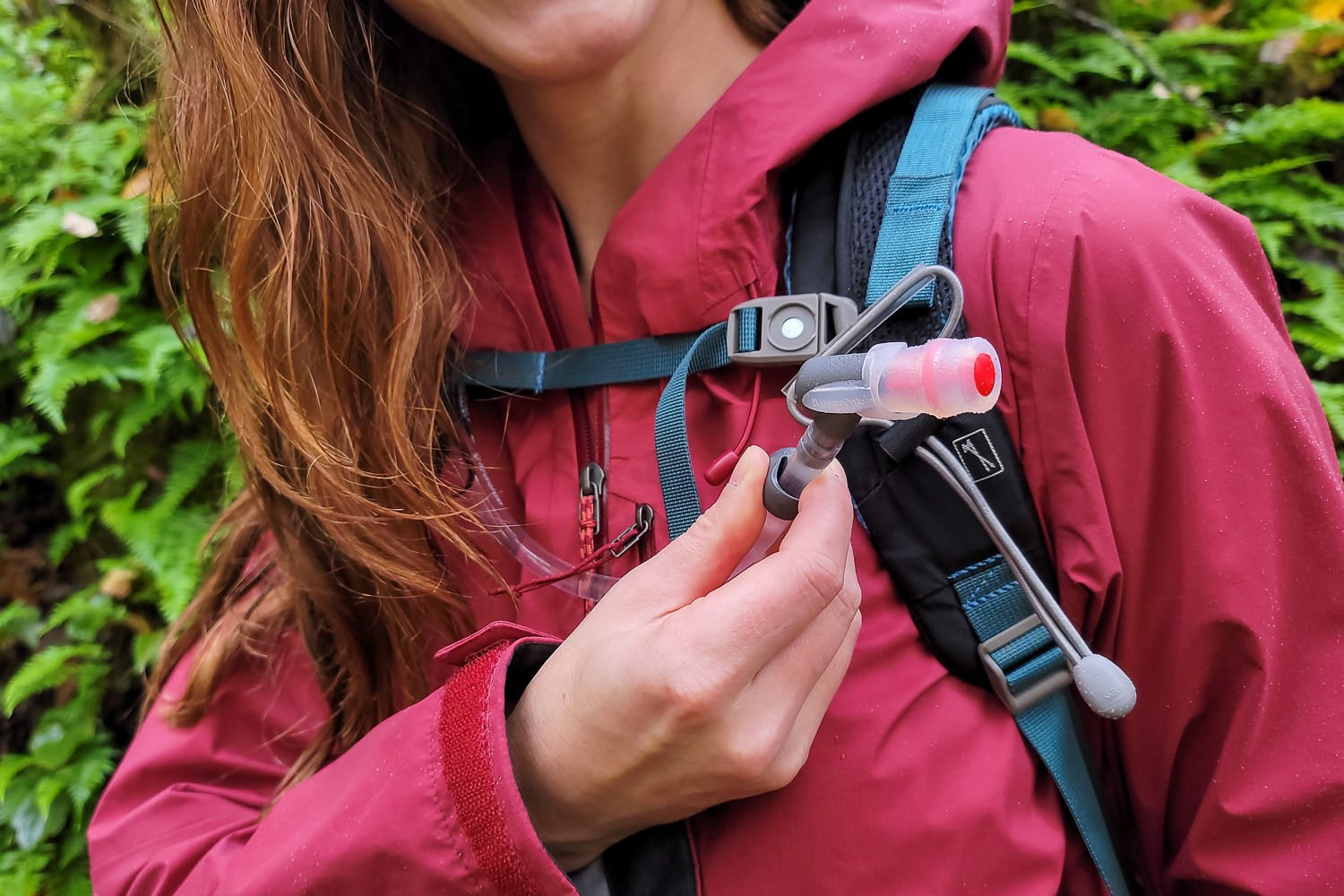What is a hydration pack?
One cloth sack, two carriers: the gym bag was once the normal way of transporting your sports equipment. - but neither practical nor convenient. A modern hydration pack, on the other hand, is a real multi-talent. We'll show you six models that are well thought out, comfortable, small, and fairly light. All of them hold a hydration bladder with a capacity of 2 liters (included in the scope of delivery) and an additional 3 to 6 liters of luggage and tools. That's enough for the evening lap, the day tour, or a racing stage.
A hydration pack for mountain biking ensures a constant supply of fluids on mountain bike tours - and you can keep your hands on the handlebars. Lightweight backpacks with hydration bladders and a few liters of packing volume are ideal for day trips or for stage and enduro races.
The oversize bladder is housed in a separate compartment so that it can be filled up at water sources or from the tap. The drinking tube is guided via an outlet on the shoulder strap to either a handlebar-mounted hydration system, e.g. for cross-country biking, or a handheld bottle if you're trail riding.
The backpacks are not only made for mountain bikers but are also used by runners and hikers who need to keep their hands free.
This buyer's guide will show you the best hydration packs for mountain biking.

What do I need a pack like that for?
A backpack is an important piece of equipment for long off-road tours or stage races such as the marathon series where you need to carry two liters of liquid on your back. Hydration bladders with a capacity of up to three liters ensure that you always have enough fluid on board.
One advantage here: You can fill them up at any water source along the route or even from the tap - without having to take off the backpack.
In addition, the drinking tube is always available for quick sipping without having to take the pack off your back every time. A few good models also come with a water level indicator, so you can see at a glance how much fluid is left in the reservoir.
Who needs a hydration pack?
Anyone who takes part in longer cycling tours or multi-day stage races will appreciate a reliable and comfortable way of staying well-hydrated along the way - be it on mountain bike trails or country roads. In comparison to normal bottles, bladders are more hygienic and easier to clean because they do not have an opening that comes into contact with dust from dry terrain or mud from wet ground.
Another significant advantage: Unlike bottles, hydration bladders can be easily refilled from any water source or tap.
In addition to long-distance cyclists and cross-country riders, runners and hikers even use hydration packs with a few liters of storage volume for shorter trips.
No matter if it's a multi-day hike in the Alps or a training tour near home: If you want to go light and compact but don't want to do without fluids on the road, then a lightweight backpack with at least one liter of carrying capacity is a must.
These days there are also mountain bike backpacks that come equipped with a special pocket for an oversize 2-3 liter hydration bladder. With this multi-functional model, you have enough space to carry all the necessary equipment for multi-day tours including food, spare clothes, and first aid supplies.

What are the differences between mountain biking hydration packs?
The most important factor in deciding on a light daypack for cycling is that water does not slosh around when you freewheel downhill or ride over bumpy trails. So you should pay attention to how well the pack stays upright and fits your body. Some packs come with a separate compartment for storing bulky items such as a pump and tools so they do not push against your back and keep your center of gravity low.
Since many backpack manufacturers also sell top-quality running hydration packs, water-resistant textiles such as nylon or polyester are often used in their construction - but keep in mind, there are also cycling backpacks made of waterproof materials. It is particularly important to look out for this if you want to take part in cyclo-cross or downhill racing.
Which features do I need?
When looking for the perfect hydration pack, then look at the storage volume and consider how much fluid you will need for your tours. Also pay attention to what equipment you might want to carry along with you - such as tools, spare inner tubes, energy bars, or a map. If possible it's good if everything fits inside without having to leave water bottles behind (may be added later).
Most packs come equipped with an oversize drinking tube that has its own exit close to the shoulder strap so that it never gets in the way when you drink. Many packs also have a water level indicator that shows how much liquid is left in the reservoir. The waist belt should be padded and adjustable so that it sits comfortably on your hips to avoid pressure points.
Some hydration packs also come with an integrated helmet holder for particularly shortstops, which will save you space when packing up at the end of the day. If possible, choose a backpack with several external pockets so that you can easily access snacks or energy bars throughout your tour. Also, pay attention to the number of openings provided by the fastening system - this should correspond to how many items are being carried around inside.
How do I clean my hydration pack?
Due to their easy-to-clean material, hydration packs are especially hygienic and durable. If you do not clean your pack often enough bacteria can start to spread in the reservoir - this is why you should rinse it out with water after each use and let it dry completely in a cool place (e.g. on the radiator). If there is still some residue left in the tube after cleaning, try scrubbing it with a toothbrush and some baking soda or vinegar.
Any other tips? It's always good to keep in mind: When using any backpack, make sure that no items press too hard against your spine - be aware of how well the fit sits! The right lighting system for mountain biking can make cycling much safer at night.
If you are out cycling for longer periods of time, you should choose the best hydration pack for mountain biking with lots of space instead of one that's too small - but it shouldn't be too bulky so you can still pedal well.
Another option would be to use a waist belt or backpack hydration system. However, this will only work if your bike has sufficient bottle mounts (front & rear). Bikepacking bags can store everything including food inside - taking up no room on your bike frame and keeping the center of gravity low.
The most important thing is to always plan ahead, foresee your needs for food and water and carry them with you accordingly. Also, it's good to bring a patch kit just in case something goes wrong on the trail that requires immediate attention - such as a tear or hole in your tire.
TIP: If hydration packs seem too bulky for your liking, beltpacks are more streamlined and offer similar storage space (if not more). They can be attached safely onto any mountain bike with two straps underneath the top tube and usually come with lots of attractive features like external pockets for snacks or tools. However, do make sure to check out which items need fixing on your frame before attaching a bag.
If you still think hydration packs are not for you, then fanny packs or bottle carriers might be the perfect alternative - they also come in all different colors and designs so you can pick one that matches your bike or personal style.
When using any backpack, make sure that no items press too hard against your spine - be aware of how well the fit sits! The right lighting system for mountain biking can make cycling much safer at night.
Best Hydration Packs
With numerous brands on the market today, it can seem overwhelming to find the best hydration pack for mountain biking that meets your needs. There are also many different types available, each with their own unique features and purposes. Here is a list featuring some of the best hydration packs for any type of cycling, along with an in-depth description of each product's main features.
Camelbak Rogue
The two-liter bladder can be filled from the outside. There is space for accessories in two small compartments, the pump in the open drawer on the outside. The rogue sits high on the back. The straps are unusually tight under the armpits. On the descent, the little one can slip up.
Ergon BE1 Enduro
This one looks like a camel! The BE1 has two humps: The water reservoir is located at the bottom, so the center of gravity is very low. In connection with the adjustable back length and the wide hip belt, it sits very stably on the back. The tools are stored in the upper compartment, albeit fairly cramped. The Ergon BE1 has a protector and is therefore well suited for enduro races.
Evoc CC 3l Race
Every second counts in a race. That's why everything is just a handgrip away with the Evoc CC 3l Race. The gel is in the practical quiver on the shoulder strap. Tools and latches in the large hip pockets, and even the attached mesh pocket on the back, can be reached while driving. Although the Evoc has the smallest volume, it sits lightly, comfortably, and securely on the back.
Platypus Tokul XC 5.0
With the Platypus, the hydration bladder dangles from a practical holder in the extra compartment. This leaves enough space in the front compartment for accessories. In the deep, dark drawer you can lose track of things. The wide shoulder straps and the stable back section are comfortable to wear. Practical: the magnetic holder for the drinking tube.
Scott Airstrike Hydro 4
The Airstrike has the biggest flap - at least in the test. The main compartment opens wide and is easy to pack. Two front compartments hold a mobile phone and tools. The hydration bladder rests on a plastic frame. This is good because the flexible back of the backpack bulges slightly. The wide hip belt with drawers holds the Scott Airstrike in place pretty well while driving.
Shimano Ounces II 6
The ounce sticks to your back like a frog willing to mate. The internal and external adjustable carrying system closes like an X in front of the chest and sits very securely. Tools, cell phone, glasses, hydration bladder - there is an extra compartment for everything. That weighs on the scales but also cleans up the booth. You reach into the main compartment from the side, from the left or right - very practical.
